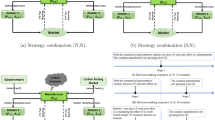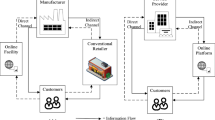Abstract
This paper aims to explore the optimal pricing and green service decisions and discuss the evolutionary stability strategy (ESS) of vertical channel structure strategic interaction between the traditional and green service supply chains (TSSC and GSSC). Considering these two supply chains could choose between the centralized (C) and decentralized (D) channel structures, current research establishes four channel models, namely, Models DD, DC, CD and CC, wherein Model DD(CC) means that both supply chains adopt channel D(C) and Model DC(CD) refers to GSSC adopting channel D(C) while TSSC using channel C(D). Furthermore, an evolutionary game is developed to explore the ESSs of the dynamic competitive system. The research results show that the stronger the integration between upstream and downstream firms of GSSC is, the higher green service the supply chain would provide when TSSC adopts channel D. Besides, when the market competition is sufficiently low, only point (0,0) is the ESS; when it is moderate, there exist two ESSs, i.e., ESS (0,0) and ESS (1,1); when it is extremely high, only point (1,1) is the ESS. The numerical examples show that the green service level increases in market competition while some retailing and wholesale prices under specific models would not be affected by it or show an inverted U shape, and the initial states of two supply chains’ channel strategies significantly impact the system’s ESSs.





Similar content being viewed by others
Data availability
Enquiries about data availability should be directed to the authors.
References
Bendadou A, Kalai R, Jemai Z, Rekik Y (2021) Impact of merging activities in a supply chain under the guaranteed service model: Centralized and decentralized cases. Appl Math Model 93(2):509–524
Chan HK, Yee RWY, Dai J, Lim MK (2016) The moderating effect of environmental dynamism on green product innovation and performance. Int J Prod Econ 181:384–391
Chen Z, Tian C, Zhang D (2019) Supply chains competition with vertical and horizontal information sharing. Eur J Ind Eng 13(1):29–53
Chen MH, Wei H, Wei M, Huang H, Su C (2021) Modeling a green supply chain in the hotel industry: an evolutionary game theory approach. Int J Hosp Manag 92:102716
Chu CP, Chung KC (2016) A framework model for assessing sustainability strategies for tourism green supply chain management. J Test Eval 44(3):1390–1399
Dan B, Xu G, Liu C (2012) Pricing policies in a dual-channel supply chain with retail services. Int J Prod Econ 139(1):312–320
Deng W, Feng L, Zhao X, Lou Y (2020) Effects of supply chain competition on firms’ product sustainability strategy. J Clean Prod 275:124061
Fan X, Guo X, Wang S (2022) Optimal collection delegation strategies in a retail-/dual-channel supply chain with trade-in programs. Eur J Oper Res. https://doi.org/10.1016/j.ejor.2022.02.053
Ghosh D, Shah J (2012) A comparative analysis of greening policies across supply chain structures. Int J Prod Econ 135(2):568–583
Goodarzi M, Makvandi P, Saen RF, Sagheb MD (2017) What are causes of cash flow bullwhip effect in centralized and decentralized supply chains? Appl Math Model 44:640–654
Hafezalkotob A (2015) Competition of two green and regular supply chains under environmental protection and revenue seeking policies of government. Comput Ind Eng 82:103–114
He P, He Y, Xu F (2018) Evolutionary analysis of sustainable tourism. Ann Touris Res 69:76–89
He Y, He P, Xu F, Shi C (2019) Sustainable tourism modeling: pricing decisions and evolutionarily stable strategies for competitive tour operators. Tour Econ 25(5):779–799
He P, He Y, Tang X, Ma S, Xu H (2022) Channel encroachment and logistics integration strategies in an e-commerce platform service supply chain. Int J Prod Econ 244:108368
Heydari J, Govindan K, Basiri Z (2021) Balancing price and green quality in presence of consumer environmental awareness: a green supply chain coordination approach. Int J Prod Res 59(7):1957–1975
Hong Z, Guo X (2019) Green product supply chain contracts considering environmental responsibilities. Omega-Int J Manage Sci 83:155–166
Hong JH, Liu X (2022) The optimal pricing for green ride services in the ride-sharing economy. Transp Res Part D-Transp Environ 104:103205
Hong Z, Dai W, Luh H, Yang C (2018) Optimal configuration of a green product supply chain with guaranteed service time and emission constraints. Eur J Oper Res 266:663–677
Huang Q, Yang S, Shi V, Zhang Y (2018) Strategic decentralization under sequential channel structure and quality choices. Int J Prod Econ 206:70–78
Jafarian E, Razmi J, Tavakkoli-Moghaddam R (2019) Forward and reverse flows pricing decisions for two competing supply chains with common collection centers in an intuitionistic fuzzy environment. Soft Comput 23:1–24
Laari S, Tyli J, Ojala L (2018) The effect of a competitive strategy and green supply chain management on the financial and environmental performance of logistics service providers. Bus Strateg Environ 27(7):872–883
Li X, Li Y (2016) Chain-to-chain competition on product sustainability. J Clean Prod 112:2058–2065
Li G, Li L, Sun J (2019a) Pricing and service effort strategy in a dual-channel supply chain with showrooming effect. Transp Res Part E Logist Transp Rev 126:32–48
Li G, Li L, Sethi SP, Guan X (2019b) Return strategy and pricing in a dual-channel supply chain. Int J Prod Econ 215:153–164
Li J, Yang S, Shi V, Zhai S (2020a) Partial vertical centralization in competing supply chains. Int J Prod Econ 224:107565
Li J, Yi L, Shi V, Chen X (2020b) Supplier encroachment strategy in the presence of retail strategic inventory: Centralization or decentralization? Omega-Int J Manage Sci 13:102213
Li ZP, Wang JJ, Perera S, Shi J (2022) Coordination of the supply chain with Nash bargaining fairness concerns. Transp Res Part E Logist Transp Rev 159:102627
Liu P, Zhang FJ (2022) Pricing strategies of dual-channel green supply chain considering big data information inputs. Soft Comput 26(6):2981–2999
Liu L, Feng L, Jiang T, Zhang Q (2021) The impact of supply chain competition on the introduction of clean development mechanisms. Transp Res Part E Logist Transp Rev 155:102506
Liu K, Li W, Cao E, Lan Y (2022) Comparison of subsidy strategies on the green supply chain under a behaviour-based pricing model. Soft Comput 26:6789–6809
Ma SG, He Y (2022) Investment of green technology in a tourism supply chain under competition. IEEE Trans Eng Manage. https://doi.org/10.1109/TEM.2022.3151349
Ma N, Gao R, Wang X, Li P (2020) Green supply chain analysis under cost sharing contract with uncertain information based on confidence level. Soft Comput 24:2617–2635
Ma SG, He Y, Gu R (2021) Joint service, pricing and advertising strategies with tourists’ green tourism experience in a tourism supply chain. J Retail Consum Serv 61:102563
Moradinasab N, Amin-Naseri MR, Behbahani TJ, Jafarzadeh H (2018) Competition and cooperation between supply chains in multi-objective petroleum green supply chain: a game theoretic approach. J Clean Prod 170(1):818–841
Nematollahi M, Tajbakhsh A, Sedghy BM (2021) The reflection of competition and coordination on organic agribusiness supply chains. Transp Res Part E Logist Transp Rev 154:102462
Nouri-Harzvili M, Hosseini-Motlagh SM, Pazari P (2022) Optimizing the competitive service and pricing decisions of dual retailing channels: a combined coordination model. Comput Ind Eng 163:107789
Peng H, Pang T, Cong J (2018) Coordination contracts for a supply chain with yield uncertainty and low-carbon preference. J Clean Prod 205:291–302
Schmitt AJ, Sun SA, Snyder LV, Shen ZJM (2015) Centralization versus decentralization: risk pooling, risk diversification, and supply chain disruptions. Omega-Int J Manage Sci 52:201–212
Sinayi M, Rasti-Barzoki M (2018) A game theoretic approach for pricing, greening, and social welfare policies in a supply chain with government intervention. J Clean Prod 196:1443–1458
Song H, Gao X (2018) Green supply chain game model and analysis under revenue-sharing contract. J Clean Prod 170:183–192
Tian Y, Govindan K, Zhu Q (2014) A system dynamics model based on evolutionary game theory for green supply chain management diffusion among Chinese manufacturers. J Clean Prod 80(7):96–105
Tseng ML, Lim MK, Wong WP, Chen YC, Zhan Y (2018) A framework for evaluating the performance of sustainable service supply chain management under uncertainty. Int J Prod Econ 195:359–372
Wang J, Liu J (2019) Vertical contract selection under chain-to-chain service competition in shipping supply chain. Transp Policy 81(6):184–196
Wang J, Wan Q, Yu M (2020) Green supply chain network design considering chain-to-chain competition on price and carbon emission. Comput Ind Eng 145:106503
Wang TY, Chen ZS, Govindan K, Chin KS (2022) Manufacturer’s selling mode choice in a platform-oriented dual channel supply chain. Expert Syst Appl 198:116842
Wu OQ, Chen H (2016) Chain-to-chain competition under demand uncertainty. J Oper Res Soc China 4(1):49–75
Wu T, Kung CC (2020) Carbon emissions, technology upgradation and financing risk of the green supply chain competition. Technol Forecast Soc Change 152:119884
Xiao T, Choi TM, Cheng TCE (2014) Product variety and channel structure strategy for a retailer-Stackelberg supply chain. Eur J Oper Res 233(1):114–124
Xing W, Zou J, Liu TL (2017) Integrated or decentralized: an analysis of channel structure for green products. Comput Ind Eng 112:20–34
Yang J, Yu K (2019) The role of an integrated logistics and procurement service offered by a 3PL firm in supply chain. J Manag Anal 6(1):49–66
Yang F, Kong J, Liu T, Ang S (2022) Cooperation and coordination in green supply chain with R&D uncertainty. J Oper Res Soc 73(3):481–496
Yi Y, Yang H (2017) Wholesale pricing and evolutionary stable strategies of retailers under network externality. Eur J Oper Res 259(1):37–47
Zhang N, Li B (2020) Pricing and coordination of green closed-loop supply chain with fairness concerns. IEEE Access 8:224178–224189
Zhang S, Zhang J, Zhu G (2018) Retail service investing: An anti-encroachment strategy in a retailer-led supply chain. Omega-Int J Manage Sci 84:212–231
Zhu W, He Y (2017) Green product design in supply chains under competition. Eur J Oper Res 258(1):165–180
Funding
This work was supported by National Natural Science Foundation of China [Grant No. 72101039], Humanity and Social Science Foundation of Ministry of Education of China [Grant No. 21YJC630039], Natural Science Foundation of Chongqing [Grant No. cstc2021jcyj-msxmX0780], Youth Project of Chongqing Technology and Business University [Grant No. 2152017], and Startup Project for High-level Talents of Chongqing Technology and Business University [Grant No. 2055034].
Author information
Authors and Affiliations
Corresponding author
Ethics declarations
Conflict of interest
The authors report no conflict of interest.
Additional information
Publisher's Note
Springer Nature remains neutral with regard to jurisdictional claims in published maps and institutional affiliations.
Appendix
Appendix
Proof for Proposition 1 Comparing the optimal green service levels under different models yields the following results. \({S}_{1}^{CC*}-{S}_{1}^{CD*}=-\frac{a\beta }{4}<0\); \({S}_{1}^{DD*}-{S}_{1}^{DC*}=\frac{a\beta \left(2+\beta \right)\left(12+2\beta -8{\beta }^{2}+{\beta }^{4}\right)}{2\left(6-{\beta }^{2}\right)\left(3-{\beta }^{2}\right)\left(8-7{\beta }^{2}+{\beta }^{4}\right)}>0\); \({S}_{1}^{CC*}-{S}_{1}^{DD*}=\frac{a\left(2+\beta \right)\left(16-2\beta -21{\beta }^{2}+{\beta }^{3}+8{\beta }^{4}-{\beta }^{6}\right)}{2\left(3-{\beta }^{2}\right)\left(8-7{\beta }^{2}+{\beta }^{4}\right)}>0\); according to the above equations, we can derive Proposition 1.
Proof for Proposition 2 Comparing the optimal profits of GSSC under different models yields the following results. \({\Pi }_{SC1}^{DD*}-{\Pi }_{SC1}^{CD*}=\frac{-{a}^{2}}{(32{(3-{\beta }^{2})}^{2}{(8-7{\beta }^{2}+{\beta }^{4})}^{2})}\left\{(4096+6144\beta -12032{\beta }^{2}-21824{\beta }^{3}+8272{\beta }^{4}+25240{\beta }^{5}+705{\beta }^{6}-13488{\beta }^{7}-2688{\beta }^{8}+3648{\beta }^{9}+1054{\beta }^{10}-480{\beta }^{11}-164{\beta }^{12}+24{\beta }^{13}+9{\beta }^{14})\right\}\); \({\Pi }_{SC1}^{CC*}-{\Pi }_{SC1}^{DC*}=\frac{{a}^{2}(2-\beta ){(2+\beta )}^{3}(8-10{\beta }^{2}+{\beta }^{4})}{8{\left(6-{\beta }^{2}\right)}^{2}(2-{\beta }^{2})}\); based on these equations, we define \({f}_{1}\left(\beta \right)=4096+6144\beta -12032{\beta }^{2}-21824{\beta }^{3}+8272{\beta }^{4}+25240{\beta }^{5}+705{\beta }^{6}-13488{\beta }^{7}-2688{\beta }^{8}+3648{\beta }^{9}+1054{\beta }^{10}-480{\beta }^{11}-164{\beta }^{12}+24{\beta }^{13}+9{\beta }^{14}\) and \({f}_{2}\left(\beta \right)=8-10{\beta }^{2}+{\beta }^{4}\). Solving \({f}_{1}\left(\beta \right)=0\) and \({f}_{2}\left(\beta \right)=0\), we can obtain \({\overline{\beta }}_{1}\) and \({\overline{\beta }}_{2}\).
Proof for Proposition 3 comparing the optimal profits of TSSC under different models yields the following results. \({\Pi }_{SC2}^{DC*}-{\Pi }_{SC2}^{DD*}=\frac{{a}^{2}{\left(4-{\beta }^{2}\right)}^{2}{\left(2{\beta }^{2}+{\beta }^{3}-6-4\beta \right)}^{2}(6-14{\beta }^{2}+8{\beta }^{4}-{\beta }^{6})}{2(3-{\beta }^{2}){(12-8{\beta }^{2}+{\beta }^{4})}^{2}{(8-7{\beta }^{2}+{\beta }^{4})}^{2}}\); \({\Pi }_{SC2}^{CC*}-{\Pi }_{SC2}^{CD*}=\frac{{a}^{2}}{16}>0\); based on the above equations, we define \({f}_{3}\left(\beta \right)=6-14{\beta }^{2}+8{\beta }^{4}-{\beta }^{6}\). Solving \({f}_{3}\left(\beta \right)=0\), we can obtain \({\overline{\beta }}_{3}\).
Proof for Proposition 4 The conditions for different ESSs are presented in Tables
4,
5 and
6.
Rights and permissions
Springer Nature or its licensor (e.g. a society or other partner) holds exclusive rights to this article under a publishing agreement with the author(s) or other rightsholder(s); author self-archiving of the accepted manuscript version of this article is solely governed by the terms of such publishing agreement and applicable law.
About this article
Cite this article
He, P., Wang, TY. Channel structure and evolutionary stability analysis between traditional and green service supply chains. Soft Comput 27, 2465–2477 (2023). https://doi.org/10.1007/s00500-022-07689-2
Accepted:
Published:
Issue Date:
DOI: https://doi.org/10.1007/s00500-022-07689-2




